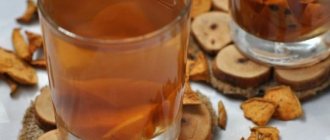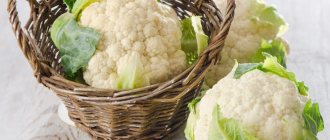Features of eating borscht while breastfeeding
After childbirth, women are forced to severely limit their diet. Although both a young mother and an infant require a huge amount of nutrients, many foods are prohibited when breastfeeding. A newborn baby, along with milk, receives all the substances that the mother consumes with food, and simply cannot absorb some of them.
Beetroot soup is allowed when breastfeeding, but not immediately after birth
We recommend reading: Beetroot: beneficial properties and contraindications
During breastfeeding, borscht must be prepared especially carefully, paying special attention to its components. Meat should be chosen lean and lean, and vegetables should be hypoallergenic and with a minimum amount of coarse fiber. Hot spices should not be added to the dish. If you take into account the child’s needs when preparing, the dish will not do any harm, but will be of great benefit.
Is it possible to eat borscht while breastfeeding?
During the breastfeeding period, women have to give up fatty and high-calorie foods, many vegetables and most fruits, canned and spicy foods. Borscht helps fill the lack of calories and nutrients. It contains not only vegetables, but also a nutritious broth with pieces of meat.
When consumed correctly, soup helps:
- eliminate calorie deficiency and cope with hunger;
- get the necessary animal protein from pieces of meat and broth;
- overcome vitamin deficiency with the help of vegetables in the dish.

Hearty beet soup improves digestion for a nursing mother
Borscht can be consumed by a nursing mother with a newborn; it becomes a valuable source of balanced carbohydrates, proteins and fats. It contains fiber that is useful for a young mother, cleanses the body, and amino acids that take part in building muscles in the baby. But the effect of a hot dish on the well-being of an infant depends on the composition.
Is it possible for a nursing mother to have borscht with beets?
Beets are one of the main ingredients in the classic soup. It is this that gives the dish its characteristic taste and red color. The benefit of beets is that they contain a lot of dietary fiber, saturate the body of the mother and infant with vitamins and organic acids, and are a source of silicon, manganese, chromium and copper.
A nursing mother can consume beetroot soup while breastfeeding. But it should be taken into account that the fiber in the vegetable can have an irritating effect on the newborn’s intestines and even lead to digestive upset. To prevent this from happening, you need to properly boil the vegetable until completely softened, this increases digestibility. For the first time, beetroot soup should be tried carefully and in small quantities to make sure that it does not cause allergies in the infant.

Beetroot in soup when breastfeeding can cause colic in a baby, so it must be boiled thoroughly
Is it possible for a nursing mother to have borscht with cabbage?
Another common ingredient in the first course is cabbage, which contains a lot of vitamins C and K. Despite all the benefits of the vegetable, it has a serious drawback - cabbage often leads to increased gas formation. This causes inconvenience even for an adult, and can cause constipation and painful colic in a baby.
Cabbage can be added to a dish for a nursing mother only when well boiled and in small quantities. Since white cabbage is especially conducive to gas formation, it is recommended to replace it with cauliflower or broccoli when breastfeeding; they have a milder effect.
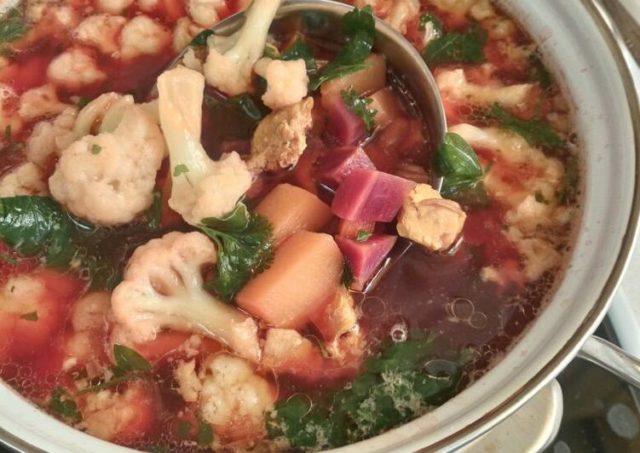
Instead of white cabbage, it is better to put cauliflower in borscht during breastfeeding; it is easier to digest
Important! Borscht with sauerkraut should be excluded from the diet when breastfeeding; such a dish will almost certainly lead to flatulence and colic.
Is green borscht okay for nursing mothers?
If beets cause an allergy or intestinal disorder in a baby, then it can be replaced with sorrel, and an egg can be added instead of meat. The so-called green borscht with egg and sorrel can bring great benefits when breastfeeding. It improves digestion, strengthens blood vessels, and most importantly, intolerance to sorrel is extremely rare.
When adding sorrel to borscht during breastfeeding, you need to remember that the plant contains many organic acids. The amount of grass should be small, no more than a couple of bunches.

Borscht with sorrel and egg is a good option when breastfeeding if there are no kidney stones or gastritis
The only contraindications to sorrel are kidney and bladder stones, as well as acute gastritis in a nursing mother while breastfeeding. For these diseases, you will have to give up green soup.
Is it possible to have borscht with vinegar while breastfeeding?
To give borscht a bright red color, a little 9% table vinegar is often added to it. Such a preservative not only makes the dish more beautiful, but also improves its taste, and also extends shelf life.
However, you should avoid using vinegar while breastfeeding. A newborn baby can react negatively to acetic acid even in small quantities.
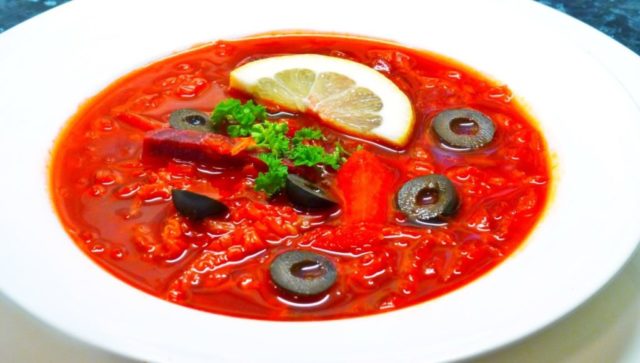
It is better to replace the vinegar in borscht with lemon when breastfeeding.
Attention! Instead of vinegar, you can add a little lemon to the soup; it is much safer and gives the same effect.
Recommendations
To minimize any negative consequences from introducing this dish into the diet of a nursing mother, you need to listen to the following tips:
- to prepare this first dish, you must use only fresh vegetables;
- it is necessary to use a minimum amount of fat;
- to prepare the broth, you need to choose lean meat, and when cooking it, remove excess fat from the surface;
- You can only eat fresh borscht that was cooked today.
Freshly cooked, low-fat and very tasty borscht, which was correctly introduced into the diet of a nursing mother, will not bring any harm to either her or her baby.
How to properly introduce it into the diet?
On a note. A nursing mother can try this dish for the first time when her child reaches the age recommended by the doctor. The best time to use it is the first two hours after the baby's morning feeding.
So, it will be almost completely digested by the mother’s body and the beneficial substances will enter the milk just in time for the next breastfeeding.
You should try freshly prepared borscht and in small quantities. The volume of the test portion should not exceed 100 ml. Over the next two days, the mother should closely monitor the child. If his behavior has not changed, he does not have diarrhea or colic, and he sleeps normally, then borscht can continue to be consumed. It is best to eat this dish no more than twice a week in the size of one medium serving.
Reference! You cannot change the recipe for borscht according to which it was first prepared. The child’s body may react negatively to any changes in the composition of the dish and the method of its preparation.
Borscht introduced into the diet of a nursing mother in accordance with all these recommendations will allow her to enjoy her favorite tasty first course without fear of a possible negative reaction from the child’s body.
When can you eat borscht while breastfeeding?
During breastfeeding, borscht is allowed for a nursing mother. However, you can’t introduce it into your diet right away; you need to adhere to a reasonable time frame. If at any stage of lactation a breastfeeding baby develops a negative reaction, the dish will need to be excluded and try to be reintroduced into the diet no earlier than a month later.
Borscht during breastfeeding in the first month
In the first month of life, the newborn’s body remains especially sensitive and reacts sharply to any unusual food. Since the healthy soup contains potentially allergenic, high-fiber vegetables and meat broth, the dish can cause serious stomach upset in an infant.
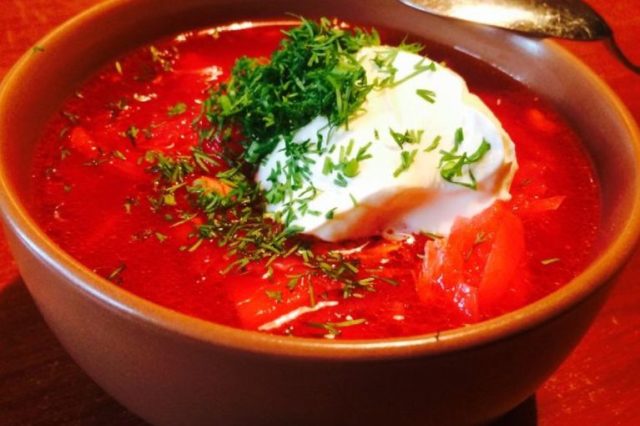
In the first month of breastfeeding, borscht should not be included in the menu.
In the first month, it is better for a nursing mother not to experiment with healthy soup. If you introduce the dish into the diet too early, the infant will develop skin rashes, flatulence and abdominal cramps.
Borscht during breastfeeding in the second month
In the second month of life, a newborn baby adapts a little to food. During this period, new dishes can be carefully added to the diet of a nursing mother, including dietary low-fat borscht. In the second month, you should try the soup without spices and bay leaves, without adding sour cream, lemon juice, much less vinegar.
For the first time, you should eat nutritious soup in the morning, in the amount of only 1 large spoon. Thus, before the evening it will be possible to understand whether the new dish is well accepted by the infant’s body, or whether it is better to postpone the introduction of the product into the diet during feeding to a later date.
Borscht during breastfeeding for the 3rd month
In the third month of life, most infants calmly accept new foods in their mother’s diet. The likelihood of developing a negative reaction to borscht is reduced; it is best to introduce the dish to the menu in the 3rd month of breastfeeding.
You still need to start tasting the soup in minimal quantities. To begin with, just 1 spoon will be enough; if beets, cabbage or other ingredients cause digestive upset in an infant, this will become noticeable by the evening. If no alarming symptoms appear either that day or the next morning, the dish can be left in the diet.

In the third month of breastfeeding, you can try borscht almost without fear.
How to properly cook borscht for a nursing mother
During the period of breastfeeding, it is advisable to slightly change the usual recipe to make the dish more dietary:
the broth for making borscht can be made from lean meat - veal, chicken fillet; It’s better not to fry; It is undesirable to use hot and spicy spices, as well as garlic; It’s good to add a lot of parsley, dill and other herbs; it is important to take only fresh homemade fruits
Classic recipe
You will need:
- veal or chicken fillet - 500 g;
- Brussels sprouts - 350 g;
- carrots - 2 small or 1 large;
- beets - two small ones;
- potatoes - 3 pcs.;
- onion - 1 pc.;
- bay leaf - 2 pcs.;
- greens, salt, sour cream - to taste;
- tomatoes - 0.5 kg.
How to cook:
- Pour water over small pieces of meat.
- Place the pan on the fire, wait until it boils and after two minutes drain the water.
- Pour new water and cook the meat in it for one and a half hours.
- Wash the vegetables prepared for borscht - Brussels sprouts, beets, carrots, potatoes, onions.
- Peel them and cut them: beets and carrots into strips, potatoes into cubes, cabbage into small pieces. Chop the onion.
- When the meat is cooked, add all the vegetables.
- Simmer over low heat with the lid closed for 15 minutes.
- Add bay leaf and salt, and after five minutes turn off the heat.
- Add greens and sour cream to each plate separately.
Using the same recipe, you can cook vegetarian borscht, if you exclude meat from it.
Video: how to cook red borscht without frying
Green borscht with sorrel
Sorrel contains many minerals and vitamins and strengthens the immune system, which is especially important during lactation. The composition of greens includes essential oils and acids that are beneficial for a woman’s health. Sorrel has a positive effect on intestinal motility, cleanses blood vessels, removes free radicals from the body and strengthens the nervous system
Sorrel has a positive effect on intestinal motility, cleanses blood vessels, removes free radicals from the body and strengthens the nervous system.
It is advisable to eat borscht with sorrel during breastfeeding no more than twice a week.
But not everyone can use it. If you have the following health problems, then it is better to avoid dishes with sorrel:
- gastritis with high acidity;
- gout;
- pancreatitis;
- stomach ulcer;
- inflammation of the genitourinary system.
To cook green borscht, you will need:
- meat - 350 g;
- potatoes - 300 g;
- sorrel - 1 small bunch;
- parsnip or zucchini - 1 small;
- carrots - 1 medium;
- green onions - 3–5 pcs.;
- greens - 2 bunches;
- salt - to taste.
How to cook:
- Pour water over the meat and cook for 1.5 hours, remembering to remove the foam.
- Peel and chop the vegetables.
- Remove the cooked meat from the broth, cut into small pieces and put back into it.
- Add carrots, zucchini, potatoes.
- After 15 minutes, add finely chopped sorrel to the broth.
- As soon as it darkens (after about 2-3 minutes), also add the greens and onions.
- Turn off the heat and leave the borscht for half an hour.
- Pour into plates, add finely chopped boiled egg (or halves), salt and sour cream to taste.
During breastfeeding, it is better to eat green borscht no more than 1-2 times a week.
Video: recipe for light green borscht for nursing mothers
You can eat borscht during lactation. But you need to introduce it into the diet gradually and carefully monitor the child’s reaction. If allergic signs appear, it is better to avoid this dish for several months and then try again.
Rules for eating borscht while breastfeeding
To prevent soup from harming a small child, it must be consumed in accordance with several rules:
- A new dish should be introduced to the menu at a time when the child is completely healthy and does not suffer from colic or teething. If the child’s health is poor, then most likely the soup will cause a negative reaction.
- You need to try the soup during the day or in the morning in order to be able to observe the baby’s behavior until the evening. Even if there are no symptoms of food intolerance, you should wait until the next day to be completely sure.
- You should not try any other new foods on the same day as soup.
If a new product was successfully introduced into the diet during breastfeeding, then it can then be consumed not only in the morning, but also during the day and in the late afternoon. At the same time, any foods during lactation should be eaten in moderation. The daily dosage of soup should not exceed 200-250 g.
Advice! Although the first dish in a nursing mother’s diet is very healthy, it is better to eat it not daily, but twice or thrice a week.
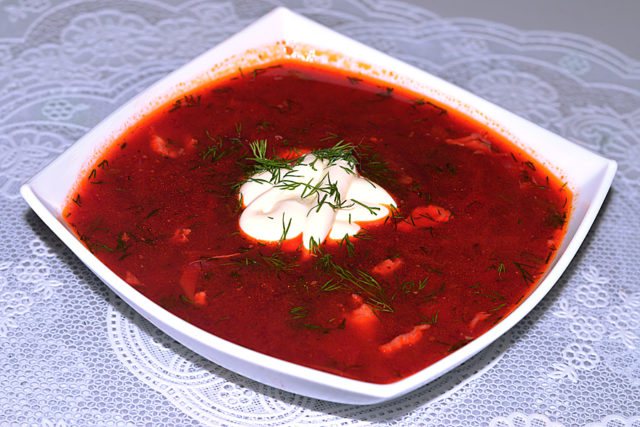
You should consume borscht when feeding an infant no more than 250 g per day.
Why a newborn may be allergic to borscht
Borscht contains foods that contain allergens: cabbage, tomatoes, beets. That's why such a reaction can occur. But each of these vegetables is very useful for both mother and child.
It is advisable to use them, but with caution and minor restrictions.
Beetroot during lactation
The vegetable is acceptable in the diet of a nursing mother, but only after heat treatment. It is rich in calcium and iodine, promotes hematopoiesis and digestion, and contains a lot of pectin and fiber.
During lactation, beets can only be eaten after heat treatment.
Can I have cabbage?
The body's reaction to cabbage depends on the amount of product consumed, as well as on the metabolism and tolerance of this vegetable. The opinion that cabbage causes bloating in a baby has not been confirmed by doctors. Therefore, you can eat cabbage after first checking the reaction of the child’s body. It is advisable to give preference to Brussels sprouts or broccoli. It can also be colored. This vegetable contains a lot of vitamin C, potassium, and iron.
To avoid problems, consume cabbage according to the following rules:
- introduce the vegetable into the menu three months after giving birth;
- stew or boil cabbage;
- eat small portions;
- Be sure to monitor your baby’s reaction and at the first sign of allergies or digestive problems, limit your cabbage intake.
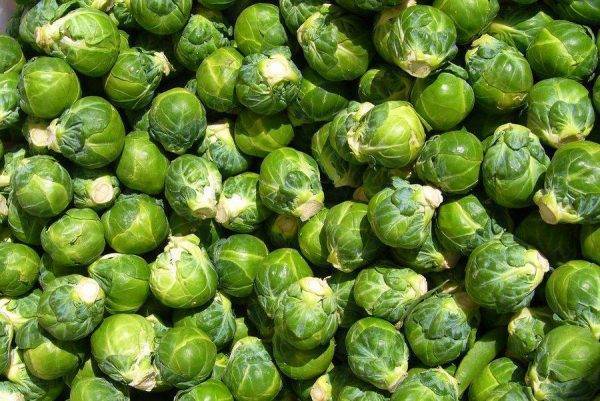
Of all types of cabbage during lactation, give preference to Brussels sprouts
Tomatoes for a nursing mother
In processed form, for example, in the form of fresh puree added to borscht or vegetable stew, tomatoes can be safely eaten during lactation. But it is also better to start with small portions.

You can eat tomatoes, but in small portions and better after heat treatment
Useful tips
To ensure that borscht during lactation is nutritious and tasty, but as harmless as possible for an infant, you need to consider several recommendations:
- Vegetables for boiling in soup must be fresh. According to the classic recipe, it is recommended to fry cabbage, beets, tomatoes and carrots before cooking, but if you are breastfeeding, it is better to avoid frying.
- For a healthy dish, you need to choose lean, dietary meat, for example, chicken fillet, lean beef or veal.
- It is better to replace the tomato paste indicated in many recipes with fresh tomatoes; ideally, they should be yellow, hypoallergenic varieties. The skins of tomatoes must be removed before cooking.
- Instead of white cabbage, it is better to take cauliflower or broccoli. They have a gentler effect on digestion, and bring no less benefits.
Recommended reading: Benefits of tomatoes for the body
In the first months of breastfeeding, it is better to eat the dish without garlic, onions and seasonings. If desired, you can add a little salt and bay leaf, but the latter needs to be kept in the soup for only a few minutes and removed. You can decorate the soup with low-fat sour cream and fresh herbs, but in small quantities.
We recommend reading: The benefits and harms of leeks
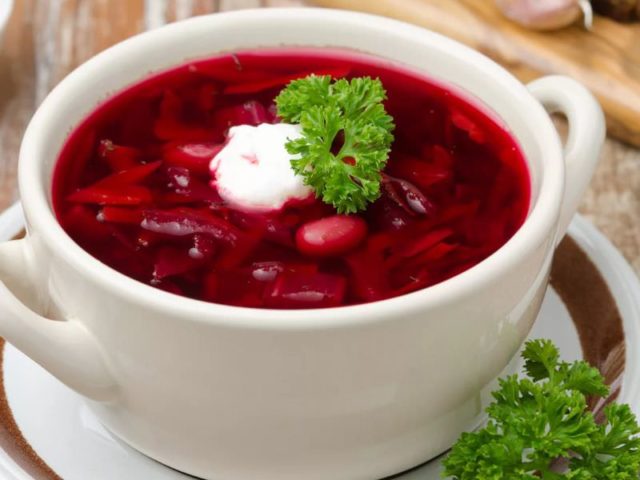
Spices and seasonings are not added to borscht during breastfeeding - it is better to get by with herbs and bay leaves





